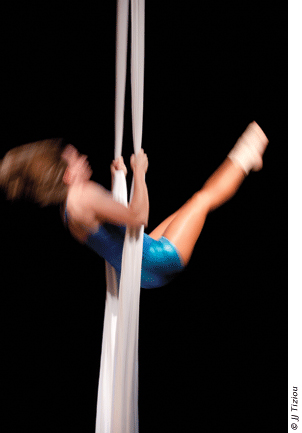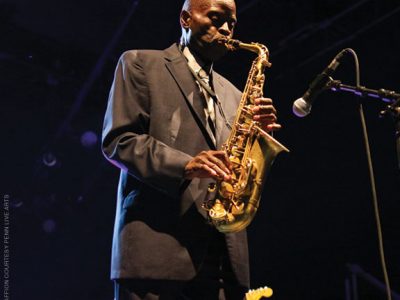
The lights are dim, and a young woman in a red negligée sleeps suspended from the ceiling. An alarm clock rings; the music begins. She awakes and shrugs off her nightgown. As she slowly descends the hank of silk fabric, 18 feet to the stage floor, she dresses again, bit by bit, in a business suit complete with a button-down shirt and sensible heels. It’s an anti-striptease, a circus act that subverts the visual tradition of women’s bodies in burlesque.
Deena Weisberg, a founding member of the University City-based, all-female aerial dance troupe Tangle Movement Arts, conceived her piece “Waking Up” as part of the company’s goal of questioning assumptions about gender and genre. Tangle’s performances incorporate circus disciplines like trapeze and aerial silks with live music, dance, and spoken word. This is exactly the circus you might expect from a company of academic acrobats.
Founded in 2010 by Lauren Rile Smith, a staff member in Van Pelt’s Rare Book and Manuscript Library (and this writer’s daughter), Tangle is an eight-member company that includes Sarah Nicolazzo Gr’14 and Kate Aid Gr’13, both PhD candidates in comparative literature; Tiffany Holder GNu’12; Lauren’s sister, Pascale, a 17-year-old high-school senior who is a member of the Penn Young Scholars program; and Weisberg, an academic psychologist and wife of Penn philosophy professor Michael Weisberg.
“We came together because we were all motivated to create a kind of performance you don’t usually get to see at the circus,” says Smith. “For example, in our 2011 Philadelphia Fringe Festival show, I collaborated with Pascale on an aerial interpretation of three works by the acclaimed poet Marie Howe. For that show, we also wanted to explore the most ordinary actions of daily life by putting them in an extraordinary context. Deena’s piece ‘Waking Up’ is my favorite example—she gives incredible dignity, grace, and specialized acrobatic skill to getting dressed in the morning, a task we all do in private every day.”
There is a political motivation behind Tangle’s decision to take circus arts beyond spandex and sparkle. From Cirque du Soleil to the increasingly popular burlesque sideshows found everywhere from Coney Island to Israel, the growing circus revival tends to be oriented in the realm of fantasy and nostalgia for an earlier age. Tangle’s response is “socially critical” circus.
“Circus has so much potential to explore radical questions about gender because it is a deeply embodied art form in which men move gracefully and women build muscle,” says Smith. Yet in spite of that radical potential, most circus performances cleave to mainstream representations of gender: a big man lifting a tiny woman.
“It’s so much rarer to see women lifting one another,” Smith points out. “It’s as if there is a fear of displaying female strength. I’ve also noticed that, by default, any emotional chemistry between performers is told as a heterosexual love story. There’s nothing wrong with those stories being told, but after a while we started to wonder, where is a more diverse reflection of the world? We saw the need for a femin-ist circus.”
In addition to their full-length performances, Tangle’s outreach program, “tinycircus,” offers free public showcases that are informally staged in the trees of University City’s Clark Park. On a warm autumn Saturday afternoon, Sarah Nicolazzo, a small, wiry woman wearing gold suspenders and a mustache drawn on with eyeliner, danced on a trapeze rigged from the branch of a tall London plane tree. The audience included picnicking hipsters, small children, neighborhood dog-walkers, and Penn students noshing on apples from the nearby farmer’s market. Some in the crowd were regular followers of Tangle; others had never seen a live circus performance before. After the applause died down, adults and kids lined up to chat with the performers and test out what it feels like to hang from a static trapeze.
“Acrobatics is a radical way to feel free and strong in your own body; we want everyone to know they have that chance,” says Smith, whose goal is to entertain and educate. Through “tinycircus,” Tangle hopes to grow a West Philadelphia acrobatic community for people of all ages, sizes, and abilities.
Unlike most dance companies, Tangle’s process is collaborative and consensus-driven, rather than the product of a single choreographer. At a recent rehearsal, members of the group sat in a circle on scattered crash mats, brainstorming ideas for their next performance. The current concept under discussion is a Venn diagram: overlapping aerial solos that represent the intersection of individual moments and chance encounters. Demonstrating her current work in process, Kate Aid rises and wraps herself in the stretchy, slippery white fabric of the silks. She rocks inside the fabric, simultaneously supported and held back, as if squeezed by a boa constrictor. Unlike Weisberg, Aid’s choreography is introspective and low to the ground, reflecting her years of ballet training. Her movements also reflect her training as a scholar—divergent historical narratives are part of the inspiration for her dance.
After Aid’s solo ends, Tangle’s academic acrobats debate ways to build on her concept, tying in the theory and narrative of the next solo. Thread by thread, a new circus fabric is woven.
—Karen Rile C’80




